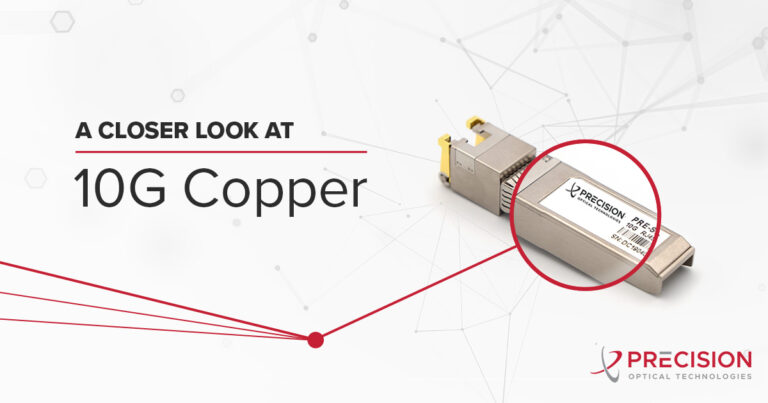
10G Network Upgrades: 3 Reasons To Choose Copper

10G copper transceivers could provide the performance upgrade you need in a cost-effective manner – here’s why.
Network virtualization, high density computing and a host of other bandwidth-intensive applications have network administrators continually recalibrating their networks while balancing budget limitations. With plenty of options in existence, including 10G SFP+ direct attach copper cables (DAC), individual SFP+ optical transceivers and 10G copper modules, how is a network operator to choose?
1. Bypassing the distance limitations of DAC
If you need a quick refresher on DAC terminology, see our recent article on DAC versus Active Optical Cables (AOC). Commonly used within storage area networks and data centers, 10G DAC is a fixed length cable with SFP+ optical transceivers integrated into both ends. Leveraging active or passive 10GbE twinaxial cabling, DAC is widely used for servers and storage devices connecting to top-of-rack (ToR) switches, as well as connecting those switches to the aggregation (spine) ones. Though cheaper than using either 10G SFP+ fiber optics or 10G copper modules, DACs feature one major logistical setback – distance.
As we noted in our article on DACs, their data transmission effectiveness is limited to a total length of 10 meters. On the other hand, 10G copper modules offer a typical reach of 30 meters with higher end equipment, such as the optics Precision OT offers, featuring an expected performance of 50 or more meters. Since equipment within a data center or other storage area networks can be more than 10 meters apart, 10G copper modules free network administrators from the fixed length restrictions of DACs, empowering them to design and operate their networks as they see fit.
2. Universal connectivity: Turning optical SFP+ ports into copper ports
When it comes to network upgrades, backwards compatibility reigns supreme. The key is to deliver optimal performance at the lowest possible cost. Today, standard SFP+ ports exist in just about all 10G equipment. That means that, in a number of cases, there may not be enough RJ45 electrical ports on switches for existing copper networking capabilities. Take this situation for instance.
Say a network administrator purchases a server with a built-in copper network interface card (NIC). Normally, to connect said NIC to a switch or router, this individual would need the receiving equipment to have corresponding electrical ports. In cases where not enough exist, going the route of 10G copper enables network administrators to effectively turn their optical SFP+ ports into electrical ones, thus enabling universal connectivity to existing copper-based servers. This same principle applies for connecting edge and core switches with 10G, where one switch features fixed copper ports and another only SFP+ optical ones.
Since copper is still less expensive than fiber, leveraging these modules can result in significant CAPEX/OPEX savings for networks in need of the 10G upgrade. It also saves network administrators the hassle and expense of purchasing media converters for copper to fiber functionality.
3. Low power, less heat
Power consumption and heat generation go hand in hand. When it comes to 100 meter or less data transmission, the choice once again comes down to SFP+ DACs or 10G copper. Here, SFP+ DACs win with an average 0.7 watt power consumption. However, based on distance limitations, 10G copper proves to be a strong competitor as it enables network administrators to run cable segments in lengths that suit their needs.
According to available data, 10G copper modules require anywhere from 2 to 5 watts to run. From a network operator perspective, however, lower is better. Most standard 10G copper transceivers have a power consumption of 3 watts. However, since wattage use turns into heat, it is impossible to place two 3 watt 10G copper modules next to each other in adjacent ports or else they will overheat, potentially leading to network downtime. Using 10G copper with lower power consumption will yield all the benefits listed above in this article without the heat issue.
What’s Next? Precision OT’s Offer
Leveraging 10G copper modules to migrate to 10GbE is an excellent solution to keep upgrade costs down. To support network administrators on their journey, we are offering our own set of 10G copper modules. Key features include:
- Operating distance of 50 meters
- Power consumption of max 2W, allowing for fully populated switch hardware with adjacent ports using 10G copper modules
- Uses CAT6A and CAT7 cables with a standard RJ-45 connector
To learn more about our 10G copper modules, visit our product page or reach out to us here and a member of our engineering team will get back to you.






